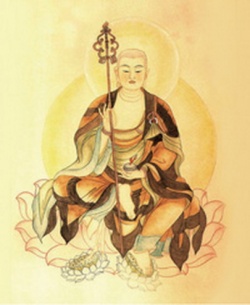Chinese Manifestations of Tibetan Buddhas - Ksitigarbha
One of the most wonderful dimensions of the Mahayana Tradition of Buddhist practice and teaching are the different manifestations of Buddha’s Qualities of compassion and wisdom. These emanate as different Buddha deities. The form, appearance, costumes, mudras, implements and jewellery of these Buddha deities differ quite considerably under Chinese & Tibetan Buddhism. Chinese & Tibetans follow the Mahayana tradition and we bring you images of five of the more popular Tibetan Buddha deities in their Chinese manifestation.
Ksitigarbha – The Bodhisattva of Great Vow ksitigarbha_00Ksitigarbha in China is known by his Chinese name Di-Zang Pu Sa (地藏菩薩) and in Tibet by his Tibetan name Sa-E Nyingpo. He is a very popular Mahayana Buddhist Bodhisattva who is usually depicted as a monk holding a six rings staff and red fire ball which is said to signify a jewel. The name Di-Zang is translated as the "Earth Treasury".
Ksitigarbha is revered as the protector of stillborn, miscarried and aborted babies. He is the protective deity of travelers and guardian of pregnant women. He protects against earthquakes; he prolongs life and is a guardian of children.
Ksitigarbha is also renowned as the Bodhisattva of Hell beings and for his vow not to achieve Buddhahood until all hells are vacated. His famous vow is recited by many Chinese Buddhists as follows "Not until the hells are emptied will I become a Buddha."
Ksitigarbha is usually shown dressed in monk's robes with a shaven head. In his left hand, Ksitigarbha holds a wish granting jewel; in his right hand, he holds a monk's staff which has six rings signifying he has attained the six perfections. Sometimes Ksitigarbha is shown wearing a crown depicting the Five Dhyani Buddhas as worn by Tibetan and Chinese monks in Tantric rituals.
The history of Ksitigarbha is described in the Sutra of The Great Vows of Ksitigarbha Bodhisattva, one of the most popular Mahayana Buddhist sutras. This sutra is said to have been spoken by the Buddha to the beings in the Heaven of the Thirty-three Deities as a mark of gratitude and remembrance for his beloved mother, Mayadevi. In the sutra, it states that Ksitigarbha practiced filial piety as a mortal, which eventually led to his making great vows to liberate all sentient beings.
In the Ksitigarbha Sutra, the Buddha reveals that in distant past eons, Ksitigarbha was a Brahman maiden by the name of Sacred Girl. She was deeply troubled when her mother died, because her mother had often been slanderous towards the Three Jewel.
To save her from the great tortures of hell, the young girl sold whatever she had and used the money to buy offerings which she offered daily to the Buddha of her time, known as The Buddha of Flower of Meditation and Enlightenment. She made fervent prayers that her mother be spared the pains of hell and requested the Buddha for help.
One day while pleading for help, she heard the voice of the Buddha advising her to go home immediately and there to sit down and recite his name if she wanted to know where her mother was. She did as she was told and while doing so, her consciousness was transported to a Hell Realm where she met a guardian who informed her that through her fervent prayers and pious offerings, her mother had accumulated much merits and had already been released from hell and had ascended to heaven.
Sacred Girl was greatly relieved and should have been extremely happy, but the sight of the great sufferings in Hell she had witnessed so touched her tender heart that she made a vow to do her very best to relieve beings of their sufferings forever in her future lives in the eons to come.
